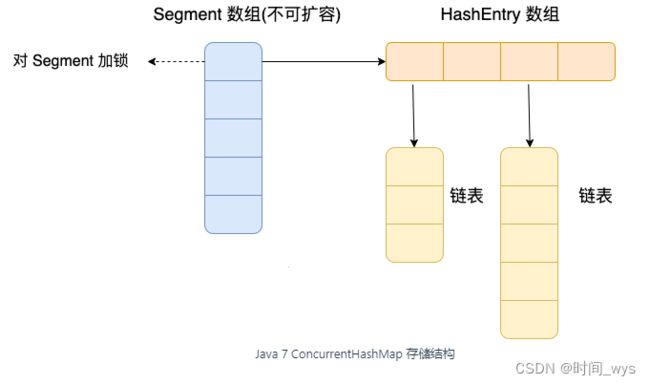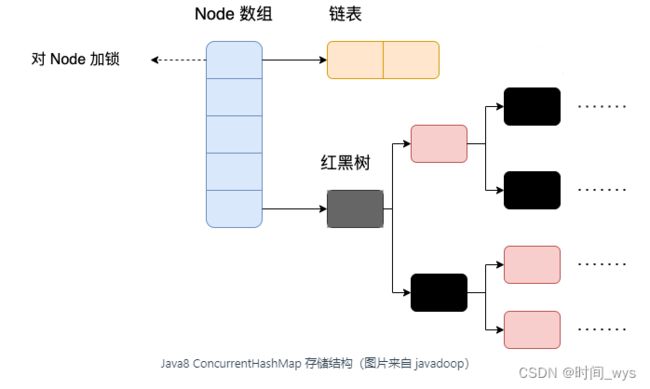【集合学习ConcurrentHashMap】ConcurrentHashMap集合学习
ConcurrentHashMap集合学习
一、JDK1.7 和 1.8 版本ConcurrenHashMap对比分析
JDK 1.7版本
在JDK 1.7版本ConcurrentHashMap使用了分段锁的方式(对Segment进行加锁),其实际结构为:Segment数组 + HashEntry数组 + 链表。由很多个 Segment 组合,而每一个 Segment 是一个类似于 HashMap 的结构,其可以进行扩容。但是 Segment 的个数一旦初始化就不能改变,默认 Segment 的个数是 16 个,你也可以认为 ConcurrentHashMap 默认支持最多 16 个并发线程。
(Segment 继承了 ReentrantLock,所以 Segment 内部可以很方便的获取锁)

JDK 1.8版本
JDK1.8版本 中的 ConcurrentHashMap 使用的 Synchronized 锁 + CAS 的机制。结构也由 Java7 中的 Segment 数组 + HashEntry 数组 + 链表 进化成了 Node 数组 + 链表 / 红黑树,Node 是类似于一个 HashMap 的结构。它的冲突再达到一定大小时会转化成红黑树,在冲突小于一定数量时又退回链表。
Java 1.8 在链表长度超过一定阈值 8 时将链表(寻址时间复杂度为 O(N))转换为红黑树(寻址时间复杂度为 O(log(N)))。Java 8 中,锁粒度更细,synchronized 只锁定当前链表或红黑二叉树的首节点,这样只要 hash 不冲突,就不会产生并发,就不会影响其他 Node 的读写,效率大幅提升。
二、JDK 1.8版本源码分析
(一)put 方法
- 根据 key 计算出 hashcode 。便于之后进一步确定Node的位置。
- 判断是否需要进行初始化。 ConcurrentHashMap 的初始化是通过自旋和 CAS 操作完成的。
- 即为当前 key 定位出的Node,如果为空表示当前位置可以写入数据,利用 CAS 尝试写入,失败则自旋保证成功。
- 如果当前位置的 hashcode ==MOVED == -1,则需要进行扩容。
- 如果都不满足,则利synchronized 锁写入数据。(synchronized锁当前Node节点,相比与JDK1.7版本的segment分段锁,锁粒度小)
- 如果数量大于一定长度TREEIFY_THRESHOLD 则要执行树化方法,在 treeifyBin 中会首先判断当前数组长度 ≥64时才会将链表转换为红黑树。
public V put(K key, V value) {
return putVal(key, value, false);
}
/** Implementation for put and putIfAbsent */
final V putVal(K key, V value, boolean onlyIfAbsent) {
// key 和 value 不能为空
if (key == null || value == null) throw new NullPointerException();
int hash = spread(key.hashCode());
int binCount = 0;
for (Node<K,V>[] tab = table;;) {
// f = 目标位置元素
Node<K,V> f; int n, i, fh;// fh 后面存放目标位置的元素 hash 值
if (tab == null || (n = tab.length) == 0)
// 数组桶为空,初始化数组桶(自旋+CAS)
tab = initTable();
else if ((f = tabAt(tab, i = (n - 1) & hash)) == null) {
// 桶内为空,CAS 放入,不加锁,成功了就直接 break 跳出
if (casTabAt(tab, i, null,new Node<K,V>(hash, key, value, null)))
break; // no lock when adding to empty bin
}
else if ((fh = f.hash) == MOVED)
tab = helpTransfer(tab, f);
else {
V oldVal = null;
// 使用 synchronized 加锁加入节点
synchronized (f) {
if (tabAt(tab, i) == f) {
// 说明是链表
if (fh >= 0) {
binCount = 1;
// 循环加入新的或者覆盖节点
for (Node<K,V> e = f;; ++binCount) {
K ek;
if (e.hash == hash &&
((ek = e.key) == key ||
(ek != null && key.equals(ek)))) {
oldVal = e.val;
if (!onlyIfAbsent)
e.val = value;
break;
}
Node<K,V> pred = e;
if ((e = e.next) == null) {
pred.next = new Node<K,V>(hash, key,
value, null);
break;
}
}
}
else if (f instanceof TreeBin) {
// 红黑树
Node<K,V> p;
binCount = 2;
if ((p = ((TreeBin<K,V>)f).putTreeVal(hash, key,
value)) != null) {
oldVal = p.val;
if (!onlyIfAbsent)
p.val = value;
}
}
}
}
if (binCount != 0) {
if (binCount >= TREEIFY_THRESHOLD)
treeifyBin(tab, i);
if (oldVal != null)
return oldVal;
break;
}
}
}
addCount(1L, binCount);
return null;
}
(二)get方法
总结一下 get 过程:
- 根据 hash 值计算位置。
- 查找到指定位置,如果头节点就是要找的,直接返回它的 value。
- 如果头节点 hash 值小于 0,说明正在扩容或者是红黑树,查找之。
- 如果是链表,遍历查找之。
public V get(Object key) {
Node<K,V>[] tab; Node<K,V> e, p; int n, eh; K ek;
// key 所在的 hash 位置
int h = spread(key.hashCode());
if ((tab = table) != null && (n = tab.length) > 0 &&
(e = tabAt(tab, (n - 1) & h)) != null) {
// 如果指定位置元素存在,头结点hash值相同
if ((eh = e.hash) == h) {
if ((ek = e.key) == key || (ek != null && key.equals(ek)))
// key hash 值相等,key值相同,直接返回元素 value
return e.val;
}
else if (eh < 0)
// 头结点hash值小于0,说明正在扩容或者是红黑树,find查找
return (p = e.find(h, key)) != null ? p.val : null;
while ((e = e.next) != null) {
// 是链表,遍历查找
if (e.hash == h &&
((ek = e.key) == key || (ek != null && key.equals(ek))))
return e.val;
}
}
return null;
}
三、JDK 1.7 和 JDK 1.8 的 ConcurrentHashMap 实现有什么不同?
- 线程安全实现方式:JDK 1.7 采用 Segment 分段锁来保证安全, Segment 是继承自 ReentrantLock。JDK1.8 放弃了 Segment 分段锁的设计,采用 Node + CAS + synchronized 保证线程安全,锁粒度更细,synchronized 只锁定当前链表或红黑二叉树的首节点。
- Hash 碰撞解决方法 : JDK 1.7 采用拉链法,JDK1.8 采用拉链法结合红黑树(链表长度超过一定阈值时,将链表转换为红黑树)。
- 并发度:JDK 1.7 最大并发度是 Segment 的个数,默认是 16。JDK 1.8 最大并发度是 Node 数组的大小,并发度更大。
